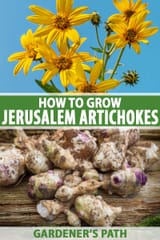Search Results
8/3/2025, 2:53:43 PM
>>512105819
I learned about sunchokes recently and wanted to share. They are similar to a sunflower but grow like a bush. They have potato like roots that are edible. Which from a survivalist perspective means that:
A. You can plant them in the garden and have 5-10kg of potato equivalents hidden away as a safety measure in case you get raided by the zog.
B. You can buy some seeds and pre-emptively guerilla plant them near your home to keep them as a stash of food.
C. They can overwinter and therefore can be eaten at any time during the year. They can keep growing year after year unlike potatoes.
>Jerusalem artichokes were first cultivated by the Indigenous peoples of the Americas, though the exact native range of the species is unknown. Genome analysis has ruled out the common sunflower (also originating in the Americas) as an ancestor, and instead points to hybridization between the hairy sunflower and the sawtooth sunflower
>By the mid-1600s, the Jerusalem artichoke had become a very common vegetable for human consumption in Europe and the Americas. The French were particularly fond of the vegetable, which reached its peak popularity at the turn of the 19th century. The Jerusalem artichoke was titled 'best soup vegetable' in the 2002 Nice Festival for the Heritage of French Cuisine.
>Jerusalem artichoke can propagate with seeds and tubers but the use of tubers leads to higher yields. For planting, the tubers are cut into pieces with three to five buds that are placed in 5–10 centimetres (2–4in) depth in the soil. Jerusalem artichoke has low nutrient requirements and needs less nitrogen than other energy crops. The competitiveness against weeds is high, making weed control easier but also making it harder to grow a different culture afterward, since some small tubers usually remain in the ground after harvest. The plant's high competitiveness may be due to allelopathic effects, high plant size, and rapid growth rate.
I learned about sunchokes recently and wanted to share. They are similar to a sunflower but grow like a bush. They have potato like roots that are edible. Which from a survivalist perspective means that:
A. You can plant them in the garden and have 5-10kg of potato equivalents hidden away as a safety measure in case you get raided by the zog.
B. You can buy some seeds and pre-emptively guerilla plant them near your home to keep them as a stash of food.
C. They can overwinter and therefore can be eaten at any time during the year. They can keep growing year after year unlike potatoes.
>Jerusalem artichokes were first cultivated by the Indigenous peoples of the Americas, though the exact native range of the species is unknown. Genome analysis has ruled out the common sunflower (also originating in the Americas) as an ancestor, and instead points to hybridization between the hairy sunflower and the sawtooth sunflower
>By the mid-1600s, the Jerusalem artichoke had become a very common vegetable for human consumption in Europe and the Americas. The French were particularly fond of the vegetable, which reached its peak popularity at the turn of the 19th century. The Jerusalem artichoke was titled 'best soup vegetable' in the 2002 Nice Festival for the Heritage of French Cuisine.
>Jerusalem artichoke can propagate with seeds and tubers but the use of tubers leads to higher yields. For planting, the tubers are cut into pieces with three to five buds that are placed in 5–10 centimetres (2–4in) depth in the soil. Jerusalem artichoke has low nutrient requirements and needs less nitrogen than other energy crops. The competitiveness against weeds is high, making weed control easier but also making it harder to grow a different culture afterward, since some small tubers usually remain in the ground after harvest. The plant's high competitiveness may be due to allelopathic effects, high plant size, and rapid growth rate.
Page 1
